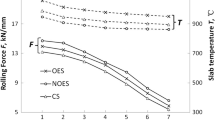Abstract
The influence of lubrication on profile and flatness control during asymmetry self-compensating work roll (ASR) hot strip rolling process is studied in order to meet the requirement of schedule-free rolling (SFR) campaigns for non-oriented electrical steel production with identical strip width. The effects of lubrication on rolling force, surface topography, and work roll wear are analyzed through experimental data. A work roll wear model for a wide non-oriented electrical steel production considered lubrication during the hot rolling process is built, which can accurately reflect the work roll wear during the hot rolling process with lubrication. A 3D finite element model for roll stack considering lubrication is built. The effects of shifting strategy on ASR work roll wear contour, loaded roll gap crown, and edge drop are analyzed based on the models. The optimal shifting rhythm is 1, and the optimal shifting step is 2 ~ 3 mm. By combining the ASR technology with lubrication, the life of work rolls expands from 70 to 100 ~ 150 by different shifting step, the loaded roll gap crown can be efficiently controlled by bending force and the edge drop control ability can be improved efficiently within an entire rolling campaign.
Similar content being viewed by others
References
Pellizzari M, Molinari A, Straffelini G (2005) Tribological behaviour of hot rolling rolls. Wear 259(7–12):1281–1289. doi:10.1016/j.wear.2004.12.006
Jiang ZY, Tang J, Sun W, Tieu AK, Wei D (2010) Analysis of tribological feature of the oxide scale in hot strip rolling. Tribol Int 43(8):1339–1345. doi:10.1016/j.triboint.2009.12.070
Cao JG, Wei GC, Zhang J, Chen XL, Zhou YZ (2008) VCR and ASR technology for profile and flatness control in hot strip mills. J Cent South Univ T 15(2):264–270. doi:10.1007/s11771-008-0049-0
Kosasih PB, Tieu AK (2007) Mixed film lubrication of strip rolling using O/W emulsions. Tribol Int 40(5):709–716. doi:10.1016/j.triboint.2006.05.010
Takami KM, Mahmoudi J, Dahlquist E, Lindenmo M (2011) Multivariable data analysis of a cold rolling control system to minimise defects. Int J Adv Manuf Tech 54(5):553–565. doi:10.1007/s00170-010-2946-2
Shirizly A, Lenard JG (2000) The effect of lubrication on mill loads during hot rolling of low carbon steel strips. J Mater Process Tech 97(1–3):61–68. doi:10.1016/S0924-0136(99)00339-8
Lo SW, Yang TC, Lin HS (2013) The lubricity of oil-in-water emulsion in cold strip rolling process under mixed lubrication. Tribol Int 66:125–133. doi:10.1016/j.triboint.2013.04.018
Azushima A, Xue WD, Yoshida Y (2007) Lubrication mechanism in hot rolling by newly developed simulation testing machine. Cirp Ann-Manuf Techn 56(1):297–300. doi:10.1016/j.cirp.2007.05.069
Jiang ZY, Tieu AK (2007) Contact mechanics and work roll wear in cold rolling of thin strip. Wear 263(7–12):1447–1453. doi:10.1016/j.wear.2006.12.068
Mancini E, Campana F, Sasso M, Newaz G (2012) Effects of cold rolling process variables on final surface quality of stainless steel thin strip. Int J Adv Manuf Tech 61(1):63–72. doi:10.1007/s00170-011-3698-3
Espinosa D, Lannoo G, Malbrancke J, Moreas G, Picard M (2010) Study of the scale behaviour in the finishing mill to improve the strip surface quality. Rev Metall 107(6):225–235. doi:10.1051/metal/2010024
Jiang ZY, Tieu AK, Sun WH, Tang JN, Wei DB (2006) Characterisation of thin oxide scale and its surface roughness in hot metal rolling. Mat Sci Eng a-Struct: A 435–436:434–438. doi:10.1016/j.msea.2006.07.070
Cao JG, Liu SJ, Zhang J, Song P, Yan TL, Zhou YZ (2011) ASR work roll shifting strategy for schedule-free rolling in hot wide strip mills. J Mater Process Tech 211(11):1768–1775. doi:10.1016/j.jmatprotec.2011.05.025
Li YL, Cao JG, Yang GH, Wen D, Zhou YZ, Ma HH (2015) ASR bending force mathematical model for the same width strip rolling campaigns in hot rolling. Steel Res Int 86(5):567–575. doi:10.1002/srin.201400133
Yang GH, Cao JG, Zhang J, Song P, Yan TL, Rao KF (2012) Profile and flatness control technology with a long shifting stroke on wide non-oriented electrical steel sheets. J Iron Steel Res Int 19(1):31–35. doi:10.1016/S1006-706X(12)60043-0
Liu L, Zang Y, Chen Y (2011) Hydrodynamic analysis of partial film lubrication in the cold rolling process. Int J Adv Manuf Tech 54(5):489–493. doi:10.1007/s00170-010-2951-5
Saniei M, Salimi M (2006) Development of a mixed film lubrication model in cold rolling. J Mater Process Tech 177(1–3):575–581. doi:10.1016/j.jmatprotec.2006.04.049
Xie H, Manabe KI, Furushima T, Tada K, Jiang Z (2016) Lubrication characterisation analysis of stainless steel foil during micro rolling. Int J Adv Manuf Tech 82(1):65–73. doi:10.1007/s00170-015-7344-3
Kimura Y, Fujita N, Matsubara Y, Kobayashi K, Amanuma Y, Yoshioka O, Sodani Y (2015) High-speed rolling by hybrid-lubrication system in tandem cold rolling mills. J Mater Process Tech 216:357–368. doi:10.1016/j.jmatprotec.2014.10.002
Kijima H (2015) Influence of lubrication on roughness crushing in skin-pass rolling of steel strip. J Mater Process Tech 216:1–9. doi:10.1016/j.jmatprotec.2014.08.010
Ahmed R, Sutcliffe MPF (2000) An experimental investigation of surface pit evolution during cold-rolling or drawing of stainless steel strip. J Tribol 123(1):1–7. doi:10.1115/1.1327580
Mancini E, Sasso M, Amodio D, Ferretti R, Sanfilippo F (2010) Surface defect generation and recovery in cold rolling of stainless steel strips. J Tribol 133(1):012202–012202. doi:10.1115/1.4002218
Sun JL (2010) Lubrication rolling process. Metallurgical Industry Press, Beijing
Azushima A, Xue WD, Yoshida Y (2009) Influence of lubricant factors on coefficient of friction and clarification of lubrication mechanism in hot rolling. ISIJ Int 49(6):868–873. doi:10.2355/isijinternational.49.868
Zhao NT, Cao JG, Zhang J, Su Y, Yan TL, Rao KF (2008) Work roll thermal contour prediction model of nonoriented electrical steel sheets in hot strip mills. J Univ Sci Technol B 15(3):352–356. doi:10.1016/S1005-8850(08)60066-3
Author information
Authors and Affiliations
Corresponding author
Rights and permissions
About this article
Cite this article
Li, Yl., Cao, Jg., Kong, N. et al. The effects of lubrication on profile and flatness control during ASR hot strip rolling. Int J Adv Manuf Technol 91, 2725–2732 (2017). https://doi.org/10.1007/s00170-016-9910-8
Received:
Accepted:
Published:
Issue Date:
DOI: https://doi.org/10.1007/s00170-016-9910-8




